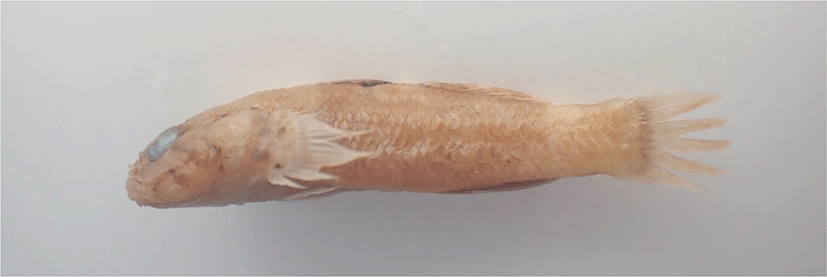Introduction
Gobiid fishes of the genus BathygobiusBleeker (1878) have been reported as a total of 28 valid species worldwide (Nelson et al., 2016). To date, four species of the genus have been documented in Korea Bathygobius coalitus (Bennett, 1832), Bathygobius cyclopterus (Cuvier & Valenciennes, 1837), Bathygobius fuscus (Rüppell, 1830), and Bathygobius hongkongensisLam, 1986 (Kwun & Kang, 2023).
The genus Bathygobius is distributed along tropical coasts and has features such as the VI first dorsal fin, branched free rays on the upper pectoral fin, the longitudinal pattern of cheek papillae, and a gill opening equivalent to the base of the pelvic fin (Akihito & Meguro, 1980; Hoese, 1986).
During the fish survey of the rocky tidal zone, we found a single gobiid fish belonging to the genus Bathygobius. It was stored as a specimen for more detailed identification, and recently, this species was identified as Bathygobius cotticeps (Steindachner, 1879) based on the morphological characters of 7 free rays on the upper pectoral fin each branch into 5 to 7, scales on the cheek and opercle, 23 predorsal scales, 24 pectoral fins, cephalic sensory canal pores H and K fused, and the middle of the pelvic frenum curved inwards smoothly, but without protrusions (Akihito & Meguro, 1980; Akihito et al., 2002). The distinctiveness of the pectoral fins in free rays was identified and compared to those of the previously announced Bathygobius to accurately identify the species. Hence, this study reports the appearance of a fifth fish belonging to the genus Bathygobius in Korea.
Materials and Methods
The single specimen was captured from the rocky tidal zone in northwest Jeju Island using a set net, fixed in 10% formalin, and subsequently preserved in 70% ethanol. Methods of counting and measurements followed by Hubbs et al. (2004) and expressed in percentages of standard length (SL) or head length (HL). Cephalic sensory canal pores and scales count method followed Uyeno et al. (1984). The specimen is deposited at the Kunsan National University, Korea.
Results and Discussion
(New Korean name: Bi-neul-mu-nui-mang-duk) (Table 1; Figs. 1 and 2).


Gobius cotticepsSteindachner (1879): 137 (Society Islands, French Polynesia).
B. cotticeps (Steindachner, 1879): Akihito & Meguro, 1980: 229; Uyeno et al., 1984: 273 (Japan); Hoese, 1986: 781; Akihito et al., 2002: 1219 (Japan).
B. cotticeps, AREIS-0002, 41.0 mm SL, was collected from the Aewol-eup, Jeju-si, Jeju-do Island, Korea, using a hand net on 18 November 2011. It lived in rocky intertidal areas, hiding in algae and rocky crevices.
Meristic and measurements are shown in Table 1. Body moderate and compressed posteriorly. Body covered in scales from predorsal to caudal fin base. Head depressed with slight triangular cross section. Anterior nasal pores cylindrical and covered skin flap. Snout short. Mouth terminal and maxilla slightly extend beyond the anterior border of the eye. Opercle and upside cheek covered with scales. Pectoral fin rounded shape. Free rays on the upper part of the pectoral fin and at each branched, respectively (5 to 7). Pelvic fin united, forming like a disc. Middle of pelvic frenum curved inwards smoothly not convexity. Anal fin originates posterior to the second dorsal fin. Length of second dorsal fin base longer than anal fin base length. Margin of caudal fin rounded.
Cephalic sensory canal pores (Fig. 2): anterior oculoscapular canal with B’, C (single), D (single), E, F, G, and H; posterior oculoscapular canal with K and L’; the anterior and posterior oculoscapular canals are united. So, H’ and K’ pores are one opening, HK; preopercular canal with M’, N, and O’.
The body coloration changes easily depending on the surrounding environment. When fresh, the background color of the body consists of a dark brown. Upper body with some whitish brown transverse bands. No blotches alongside body. Abdominal region relatively bright. Each membrane of fins is translucent. Small dark spots concentrate on pectoral fin base. After preserved, whole body color is pale brown. Band pattern faint.
B. cotticeps is a tropical fish and has a wide distribution range. Southwestern Japan, Taiwan, western central pacific (Akihito & Meguro, 1980; Akihito et al., 2002), western coast of India (Manilo & Bogorodsky, 2003; Sreeraj et al., 2022), and Korea (this study).
The present specimen collected from Jeju-do Island, Korea, matched with characters of the genus Bathygobius and was identified as B. cotticeps by the following meristic count features 23 pectoral fin rays, 7 free rays on the upper pectoral fin part, 5–7 branches of free ray, 23 predorsal scales, 38 longitudinal scales, and cephalic sensory canal pores H and K fused (Akihito & Meguro, 1980). The original description of B. cotticeps is considerably insufficient, particularly with the number of longitudinal scales being 33, However Akihito & Meguro (1980) confirmed the holotype and used a longitudinal scale range of 35–46 as the standard in this study.
These features distinguish B. cotticeps from the other four Bathygobius species in Korea. B. cotticeps has 21–25 pectoral fins (vs. 17–20 in B. coalitus and 16–20 in B. fuscus), 21–32 predorsal scales (vs. 13–17 in B. hongkongensis and 12–20 in B. cyclopterus), connected cephalic sensory canal pore (HK) is present only in B. cyclopterus, and scales on the cheek which are only present in B. cotticeps, unlike the other four species (Akihito & Meguro, 1980; Akihito et al., 2002; Lam, 1986).
We, therefore propose a new Korean name, “Bi-neul-mu-nui-mang-duk” for B. cotticeps, which refers to the presence of scales on the cheeks.
